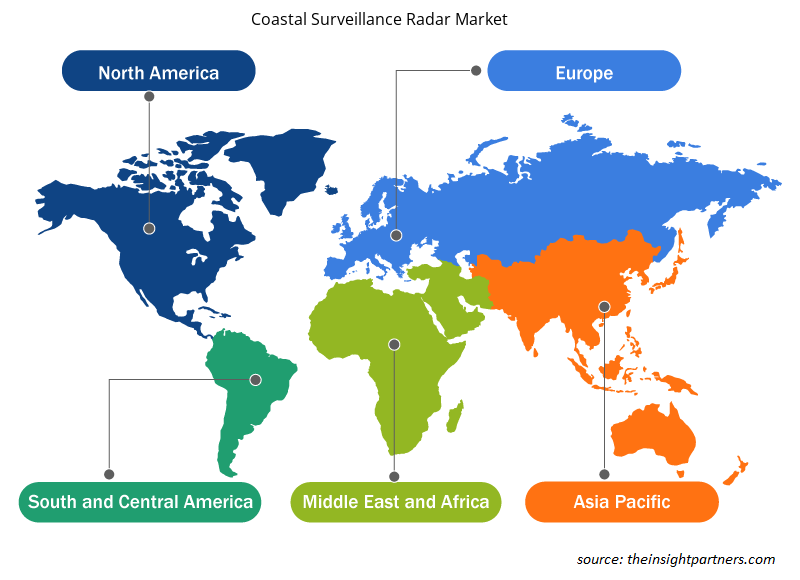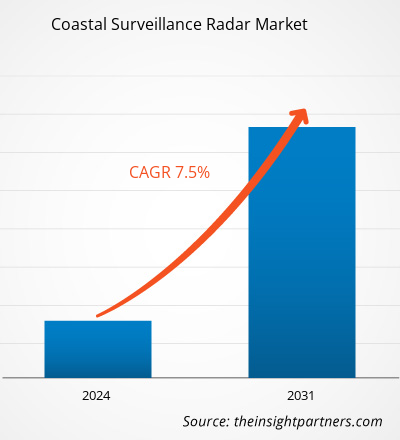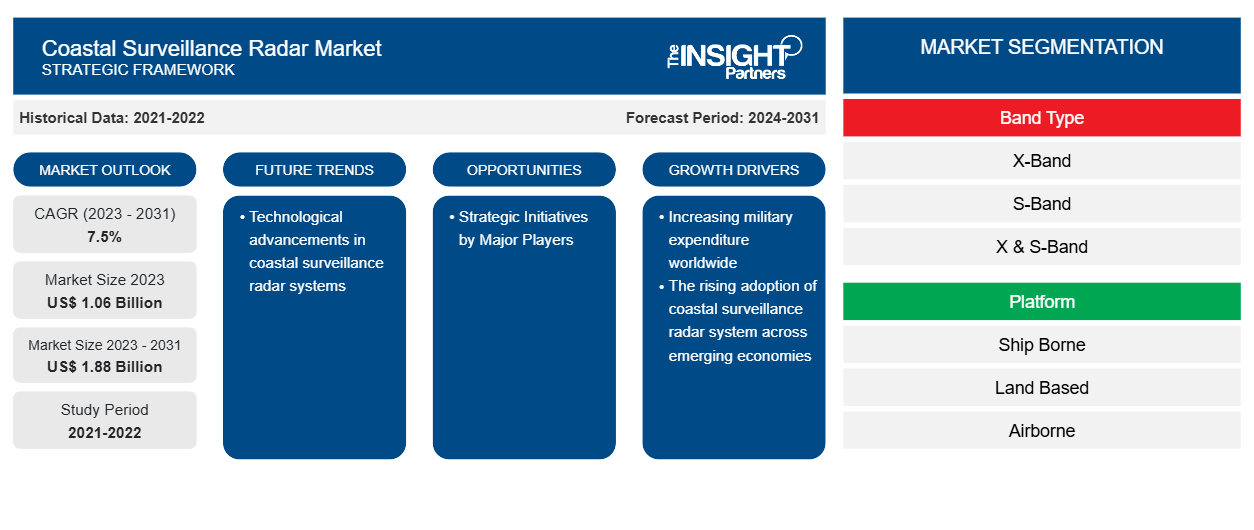Se prevé que el tamaño del mercado de radares de vigilancia costera alcance los 1.880 millones de dólares en 2031, frente a los 1.060 millones de dólares en 2023. Se espera que el mercado registre una CAGR del 7,5 % durante el período 2023-2031. Es probable que los avances tecnológicos en los sistemas de radares de vigilancia costera sigan siendo una tendencia clave en el mercado.
Análisis del mercado de radares de vigilancia costera
Elbit Systems Ltd, Thales Group, Israel Aerospace Industries, Hensoldt AG y Terma A/S son algunos de los actores clave del mercado que operan en el mercado global de radares de vigilancia costera. Estas empresas se dedican al desarrollo de sistemas robustos que incluyen radares de banda X, banda S y bandas X y S para varios usuarios finales. Además, estas empresas también disfrutan de un número sustancial de contratos para sus radares de varias fuerzas navales, guardias costeros, compañías de petróleo y gas, así como puertos. Las empresas firman acuerdos a largo plazo con los usuarios finales para respaldar el suministro de productos de radar de vigilancia costera, lo que les permite generar ingresos año tras año.
Descripción general del mercado de radares de vigilancia costera
Los principales actores en el ecosistema del mercado global de radares de vigilancia costera incluyen fabricantes de componentes, integradores de sistemas y usuarios finales, entre otros. Un radar de sistema de vigilancia costera se compone de varios componentes que son adquiridos por los fabricantes de sistemas de una enorme base de fabricantes de componentes. Estos fabricantes de componentes suministran las piezas base a los actores globales de radares de vigilancia costera. Los integradores de sistemas son las empresas que se dedican a la fabricación de los sistemas de radar de vigilancia finales después de integrar cada componente. El usuario final del mercado global de radares de vigilancia costera incluye tanto a los organismos gubernamentales como a las organizaciones privadas que realizan negocios en toda la costa. Las empresas multinacionales de petróleo y gas en tierra que están en las costas dependen en gran medida de los radares de vigilancia para garantizar la seguridad en sus operaciones y en sus activos. Por otro lado, el aumento del gasto militar de las naciones desarrolladas y en desarrollo y sus crecientes inversiones para asegurar las fronteras terrestres y costeras de factores como el tráfico de drogas, el terrorismo y los inmigrantes indocumentados, entre otros, también están impulsando la alta adopción de radares de vigilancia costera por parte de los organismos gubernamentales.
Personalice este informe según sus necesidades
Obtendrá personalización en cualquier informe, sin cargo, incluidas partes de este informe o análisis a nivel de país, paquete de datos de Excel, así como también grandes ofertas y descuentos para empresas emergentes y universidades.
-
Obtenga las principales tendencias clave del mercado de este informe.Esta muestra GRATUITA incluirá análisis de datos, desde tendencias del mercado hasta estimaciones y pronósticos.
Factores impulsores y oportunidades del mercado de radares de vigilancia costera
Creciente adopción de sistemas de radar de vigilancia costera en las economías emergentes
Se espera que el aumento de las amenazas fronterizas en economías emergentes como China, India, Taiwán, Corea del Sur, Rusia, Ucrania, Israel, Palestina e Irán impulse la adopción de sistemas de radar de vigilancia costera. Debido al aumento de la guerra marítima y las insurgencias oceánicas, las regiones costeras de estas economías se están volviendo cada vez más vitales, y el radar de vigilancia desempeña un papel crucial en la detección de amenazas en tiempo real. Los comandantes pueden obtener información valiosa sobre los movimientos del enemigo y sus alrededores mediante el despliegue de sistemas de radar avanzados a lo largo de los límites costeros, tomando así las medidas necesarias basadas en datos en tiempo real. Este beneficio de recopilar datos en tiempo real con imágenes claras y de alta resolución es el punto de atracción crucial para los usuarios finales. Por lo tanto, gracias a los parámetros cruciales, el mercado de radares de vigilancia costera ha estado creciendo en todo el mundo.
Iniciativas estratégicas de los principales actores
Las empresas que operan en el mercado de radares de vigilancia costera están adoptando estrategias de crecimiento orgánico e inorgánico, como altas inversiones, ofertas de productos y expansión global, creando aún más oportunidades de crecimiento para el mercado global de radares de vigilancia costera. Algunos desarrollos clave que se pueden mencionar son:
- En septiembre de 2022, la Guardia Costera de EE. UU. adjudicó un contrato a L3Harris Technologies Inc. para la instalación de hasta cinco radares multimodo AN/APY-11 en los nuevos aviones de vigilancia de largo alcance C-130J Super Hercules durante el proceso de puesta en servicio del Minotaur. El contrato a precio fijo en firme es para la entrega de tres radares multimodo, que serán instalados por L-3 Communication Integrated Systems en Waco, Texas, durante la puesta en servicio y la actualización del Bloque 8.1 de los aviones C-130J n.º 18, 19 y 20 de la flota de la Guardia Costera.
- En diciembre de 2022, LIG Nex1 Co firmó un acuerdo con el Comando Logístico Naval para el proyecto Radar de Vigilancia Marítima-II.
Estos avances han generado nuevas oportunidades para los proveedores del mercado en diferentes regiones.
Análisis de segmentación del informe de mercado de radar de vigilancia costera
Los segmentos clave que contribuyeron a la derivación del análisis del mercado de radar de vigilancia costera son el tipo de banda, la plataforma y el usuario final.
- Según el tipo de banda, el mercado de radares de vigilancia costera se segmenta en banda X, banda S, banda X/S y otras. El segmento de banda X tuvo una mayor participación de mercado en 2023.
- Según la plataforma, el mercado de radares de vigilancia costera se segmenta en embarcados, terrestres y aéreos. El segmento aéreo tuvo una mayor participación de mercado en 2023.
- Según el usuario final, el mercado de radares de vigilancia costera se segmenta en puertos, compañías de petróleo y gas y agencias de patrulla marítima . El segmento de agencias de patrulla marítima tuvo una mayor participación de mercado en 2023.
Análisis de la cuota de mercado de los radares de vigilancia costera por geografía
El alcance geográfico del informe de mercado de radar de vigilancia costera se divide principalmente en cinco regiones: América del Norte, Europa, Asia Pacífico, Medio Oriente y África, y América del Sur.
América del Norte ha dominado el mercado en 2023, seguida de las regiones de Europa y Asia Pacífico. Además, es probable que Asia Pacífico también sea testigo de la CAGR más alta en los próximos años. Estados Unidos representó la mayor participación de mercado en el mercado de radares de vigilancia costera de América del Norte. Estados Unidos también es un país tecnológicamente avanzado y tiene un enorme potencial para adoptar nuevas tecnologías a lo largo de los años. Las empresas de petróleo y gas presentes en todo el país también tienen un enorme potencial para adoptar tecnologías para asegurar sus operaciones en las costas. Esto está influyendo aún más en la adopción de radares de vigilancia costera para limitar o restringir las actividades ilícitas en todo el país. Accipiter Radar Technologies Inc, Teledyne FLIR LLC, L3Harris Technologies Inc, Raytheon Technologies Corporation y SSR Engineering son algunos de los actores que operan en el mercado estadounidense.CAGR in the coming years. The US accounted for the largest market share in North America coastal surveillance radar market. The US is also a technologically advanced country and has a huge potential to adopt new technologies over the years. The oil and gas companies present across the country also have huge potential to adopt technologies for securing their operation across the coastlines. This is further influencing the adoption of coastal surveillance radars to limit or restrict illicit activities across the country. Accipiter Radar Technologies Inc, Teledyne FLIR LLC, L3Harris Technologies Inc, Raytheon Technologies Corporation, and SSR Engineering are some of the players operating in the US market.
Perspectivas regionales del mercado de radares de vigilancia costera
Los analistas de Insight Partners explicaron en detalle las tendencias y los factores regionales que influyen en el mercado de radares de vigilancia costera durante el período de pronóstico. Esta sección también analiza los segmentos y la geografía del mercado de radares de vigilancia costera en América del Norte, Europa, Asia Pacífico, Oriente Medio y África, y América del Sur y Central.

- Obtenga datos regionales específicos para el mercado de radares de vigilancia costera
Alcance del informe sobre el mercado de radares de vigilancia costera
| Atributo del informe | Detalles |
|---|---|
| Tamaño del mercado en 2023 | 1.060 millones de dólares estadounidenses |
| Tamaño del mercado en 2031 | 1.880 millones de dólares estadounidenses |
| CAGR global (2023 - 2031) | 7,5% |
| Datos históricos | 2021-2022 |
| Período de pronóstico | 2024-2031 |
| Segmentos cubiertos |
Por tipo de banda
|
| Regiones y países cubiertos |
América del norte
|
| Líderes del mercado y perfiles de empresas clave |
|
Densidad de actores del mercado de radares de vigilancia costera: comprensión de su impacto en la dinámica empresarial
El mercado de radares de vigilancia costera está creciendo rápidamente, impulsado por la creciente demanda de los usuarios finales debido a factores como la evolución de las preferencias de los consumidores, los avances tecnológicos y una mayor conciencia de los beneficios del producto. A medida que aumenta la demanda, las empresas amplían sus ofertas, innovan para satisfacer las necesidades de los consumidores y aprovechan las tendencias emergentes, lo que impulsa aún más el crecimiento del mercado.
La densidad de actores del mercado se refiere a la distribución de las empresas o firmas que operan dentro de un mercado o industria en particular. Indica cuántos competidores (actores del mercado) están presentes en un espacio de mercado determinado en relación con su tamaño o valor total de mercado.
Las principales empresas que operan en el mercado de radares de vigilancia costera son:
- Accipiter Radar Technologies Inc.
- Aselsan AS
- Sistemas de vigilancia Blighter Ltd.
- Sistemas de radar Easat Ltd.
- Elbit Systems Ltd
- Teledyne FLIR LLC
Descargo de responsabilidad : Las empresas enumeradas anteriormente no están clasificadas en ningún orden particular.

- Obtenga una descripción general de los principales actores clave del mercado de radares de vigilancia costera
Noticias y novedades del mercado de radares de vigilancia costera
El mercado de radares de vigilancia costera se evalúa mediante la recopilación de datos cualitativos y cuantitativos a partir de una investigación primaria y secundaria, que incluye importantes publicaciones corporativas, datos de asociaciones y bases de datos. A continuación, se enumeran algunos de los avances en el mercado de radares de vigilancia costera:
- Leonardo ha adquirido una participación del 30% en el capital social de GEM elettronica, una empresa italiana especializada en la producción de radares 3D de tamaño pequeño y mediano, sensores electroópticos y sistemas inerciales para los sectores marítimo, aéreo y terrestre. (Fuente: Leonardo, Nota de prensa, abril de 2021)
- El proveedor de soluciones de sensores HENSOLDT está equipando el National Security Cutter (NSC) de la clase "Legend" de la Guardia Costera de EE. UU. con su probado radar naval multimodo TRS-3D. La Guardia Costera de EE. UU. adjudicó a HENSOLDT un contrato de seguimiento por un valor aproximado de 10 millones de dólares para entregar otro radar en su última versión "Baseline D" que se instalará en el centro de entrenamiento de la Guardia Costera (TRACEN) en Petaluma/California. Hasta ahora, HENSOLDT ha entregado 12 radares al programa NSC de la Guardia Costera de EE. UU. (Fuente: HENSOLDT, comunicado de prensa, septiembre de 2023)
Informe sobre el mercado de radares de vigilancia costera: cobertura y resultados
El informe “Tamaño y pronóstico del mercado de radares de vigilancia costera (2021-2031)” proporciona un análisis detallado del mercado que cubre las siguientes áreas:
- Tamaño del mercado de radar de vigilancia costera y pronóstico a nivel mundial, regional y nacional para todos los segmentos clave del mercado cubiertos bajo el alcance
- Tendencias del mercado de radares de vigilancia costera, así como dinámicas del mercado, como impulsores, restricciones y oportunidades clave
- Análisis detallado de las cinco fuerzas de Porter
- Análisis del mercado de radares de vigilancia costera que abarca las tendencias clave del mercado, el marco global y regional, los principales actores, las regulaciones y los desarrollos recientes del mercado
- Análisis del panorama de la industria y de la competencia que abarca la concentración del mercado, el análisis de mapas de calor, los actores destacados y los desarrollos recientes del mercado de radares de vigilancia costera
- Perfiles detallados de empresas
- Análisis histórico (2 años), año base, pronóstico (7 años) con CAGR
- Análisis PEST y FODA
- Tamaño del mercado, valor/volumen: global, regional y nacional
- Industria y panorama competitivo
- Conjunto de datos de Excel
Informes recientes
Informes relacionados
Testimonios
Razón para comprar
- Toma de decisiones informada
- Comprensión de la dinámica del mercado
- Análisis competitivo
- Información sobre clientes
- Pronósticos del mercado
- Mitigación de riesgos
- Planificación estratégica
- Justificación de la inversión
- Identificación de mercados emergentes
- Mejora de las estrategias de marketing
- Impulso de la eficiencia operativa
- Alineación con las tendencias regulatorias























 Obtenga una muestra gratuita para - Mercado de radares de vigilancia costera
Obtenga una muestra gratuita para - Mercado de radares de vigilancia costera